Reasons To Consider Engineered Wood Flooring For The Hot Desert Climate
November 14, 2022
Hardwood is one of the few sustainable flooring options and is a good option if you live in a desert climate. Hardwood flooring is weather resistant and refreshing to walk on a hot day. Because the environment of a desert region is dry, you won’t have to worry about your floors swelling from dampness, humidity, and moisture. The sole effect of temperature on hardwood is the possibility of it withering, but specific organic coatings prevent this from happening.
The nice thing about hardwood is that it is available in various finishes, including solid hardwood (carved from a single block of wood), engineered hardwood (panels of plywood crisscrossed with a completed top piece), and raw hardwood.
You can be confident that whichever type of hardwood you choose will add style to your home. Another advantage of hardwood is that it can raise the value of your home.
Why Is Engineered Wood Flooring Best For Hot Desert Climate?
Engineered hardwood outperforms other types of flooring in every environment where humidity and temperature fluctuate. Engineered wood is less susceptible to temperature changes than solid wood. Engineered wood is preferred when installing below-grade, above or near-radiant heating systems or in any humid environment or climate.
Engineered wood is good at providing better durability and resistance to moisture and heat than solid wood flooring. Engineered floors have a multi-ply board construction that allows for expansion while preserving structural stability. This flooring is made from a central core of timber and wood fibers or high-density fiberboard and a top layer of veneer attached to the core’s upper layer. Under heat and pressure, these layers are fused.
Engineered flooring is a versatile option that is resistant to heat and moisture. Engineered floors are a sensible alternative to solid wood in environments where solid hardwood cannot thrive.
Advantages of Engineered Hardwood Flooring
Less Susceptibility To Moisture and Humidity
Unlike solid hardwood, engineered hardwood is built in layers. The top layer is made of wood veneer, and the core layers are made of plywood, particleboard, or fiberglass. These layers are then piled and bonded in opposite directions in a crisscross pattern. When exposed to excessive humidity, each layer compensates for the other’s natural propensity to expand or shrink, resulting in more durable flooring.
Over Concrete Installation
Because engineered wood is resistant to moisture, it can be attached or float over a concrete floor. Even though engineered boards are more resistant to temperature changes, they still contain natural timber. Before installation, make sure to saturate the subfloor and repair any cracks. Install a moisture meter to keep track of the humidity levels.
Engineered Hardwood Can Be Refinished
Sand and refinish your engineered hardwood floor if you purchased a high-quality product. You can refinish your engineered hardwood on average with one to three refinishes.
Radiant Heating Compatibility
It may be challenging to locate a solid wood that is safe to put over in-floor heating. However, most engineered hardwoods are strong enough to endure temperature fluctuations. Although there are certain exceptions, before putting engineered wood over radiant systems, try to consult your supplier.

Warm Regards,
Pauline Madani
Founder & Managing Director Nordic Homeworx





